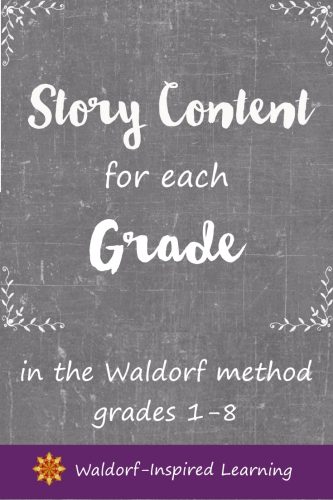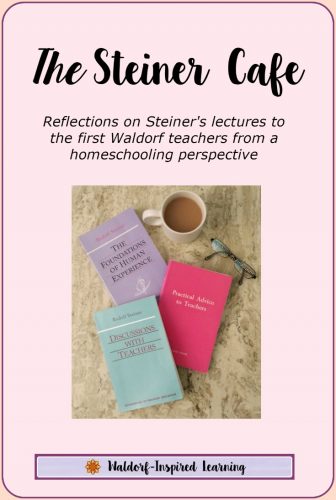In the afternoon sessions of the 14-day Seminar Course, Rudolf Steiner spoke informally to the teachers and they had an opportunity to ask questions. On this first afternoon, Steiner gives the Waldorf story content for each grade.
Steiner states that “our relationship to the children and the important thing for us to remember is the diversity of children and indeed all human beings.”
Here are a few highlights:
- The essential thing is to observe the child.
- Be patient with yourselves!
- Take one subject in Main Lessons for six to eight weeks.
- Steiner gives a list of story content for each grade.
- Education and teaching help to harmonize the four temperaments.
This is the lecture where Steiner first explains the temperaments. He says that “one of the four elements (the 4 basic types of people or constitutions from ancient times called temperaments) rules in each child, and education and teaching must harmonize these four principles.”
Steiner describes how to work with the temperaments, accepting each one rather than trying to change it directly. We want to inwardly work to invite or stretch the child toward different interests and behavior, but outwardly, meet the temperament right where each child is.
“When we want to help a temperament, the worst method is to try to foster the opposite qualities in a child. We must work to understand the temperament, to go out to meet it.”

Another rather well-known quote comes from Discussion One: “Education occurs because of what you are, rather than, let’s say, what you make of yourself when you are with the children.”
Also in Discussion One, Steiner talks about which subjects are suitable for which age and gives a list. You can find that list below.
He also says that teachers want to take a subject for a while without interruption, say six to eight weeks. This is the first mention of main lesson blocks, their subjects, and length.
Here is that first list of subjects that Steiner wrote up on the blackboard for the first teachers on August 21, 1919.
Story Content for Each Grade
Grade 1: A fund of fairy tales
Grade 2: Stories from the animal realm in fables
Grade 3: Bible stories as part of general history (Old Testament)
Grade 4: Scenes from ancient history
Grade 5: Scenes from medieval history
Grade 6: Scenes from modern history
Grade 7: Stories of various races & tribes (Indian, Chinese, American)
Grade 8: Knowledge of the races (peoples of the earth)
Steiner revised and elaborated on this list a few times during the first five years of the Free Waldorf School while he was still alive, but the core is there from the beginning, especially for grades one through four.
Most of us still follow this basic chronology! Also, there is more variability in the curriculum in grades five through eight, if only because of the sheer scope of material! There is no way to cover every detail within these broad topics. We must choose and are encouraged to choose based on what interests us as teachers.
In Discussion One, Steiner also comments on the length of main lessons each day, stating,
“Our ideal would be, therefore, not to occupy any child for longer than three and a half hours. Then the child would always be fresh. Then our only other problem would be to think of what we could do with them in the school gardens when there are not lessons.”
Keep the main lesson short! This three and a half hours is made up of movement, the main lesson work, and artistic activities.
And at home, of course, we are not challenged by what to do when there are no lessons! Steiner and most schools need to worry about this because of the state requirements that schools need to adhere to.
During the Q&A of Discussion One, a teacher asks a question on school books. Steiner suggests that the teachers look at those commonly used in schools, and then says:
“The less we need to use books the better. We need only use printed books when children need to take public exams. Initially, we should have no examination at all. The final exams are a compromise with the authorities. Prior to puberty, dread of examinations can become a driving impulse of the whole physiological and psychological constitution of the child. The best thing would be to get rid of all examinations. The child would then become much more quick-witted.”
Personally, this issue of testing has been a motivating force in our family’s choice to homeschool. Having taught in both public and private schools, I have seen first-hand both the pressure on teachers to ‘teach to the test” and the anxiety produced in the children by so many tests, often two or three large national or state tests each year starting in first grade!
I am so grateful for Steiner’s insights into children and his creation of a teaching method based on the arts rather than the tests!!!
Are you ready to learn more about the Waldorf approach and how to apply it at home? My toolkit, Homeschool Simplicity 101, can help. Gain a full understanding of the method along with guidance on how to plan for and customize your homeschool lessons.

The Steiner Cafe is a place to explore and reflect on the lectures that Rudolf Steiner gave at the Teacher’s Seminar in 1919, the very first Waldorf teacher training.
To read reflections on previous lectures, check out The Steiner Cafe.
These lectures are published in three books. Below are affiliate links for your convenience. Click here to read my full disclosure policy.
The morning lectures are found in The Foundations of Human Experience; later morning lectures in Practical Advice to Teachers; and afternoon lectures in Discussions with Teachers.
We invite you to pick up the books and read along. Or if you prefer, you can read online at www.rsarchive.org. Or listen at www.rudolfsteineraudio.com.
Lot’s of options! Hope you’ll join in the conversations.



Jean, I could not agree with more with your final comments. I thought you and your readers might enjoy this post http://teachertomsblog.blogspot.com/2014/02/this-is-child-abuse.html#.UwIay57kGf4.facebook
XOXO
A
Thanks, Andrea. I love Teacher Tom! He is a superhero for preserving childhood. Glad you suggested him here (and glad you’re here!).
Hi Jean,
No testing is one of the biggest reason why we send our children to our Waldorf school. You’re right, the pressure is too detrimental…I’m really enjoying your Steiner Cafe. Thanks for sharing! Aloha, Lori
Thanks so much, Lori. And YES! No testing and no textbooks was one of my first draws to Waldorf education when I was just out of graduate school (teacher education) and looking for “alternatives.” So glad you’re enjoying the Steiner Cafe. I too am getting so much out of re-reading these lectures with today’s world in mind. Looking forward to continuing the conversation.
Hello jean, thank you so much. Yes we also following Steiner education in our school. But we transform it into our culture and possibility so we have different Waldorf school. Thank you so much for helping us by sharing a lot of ideas.